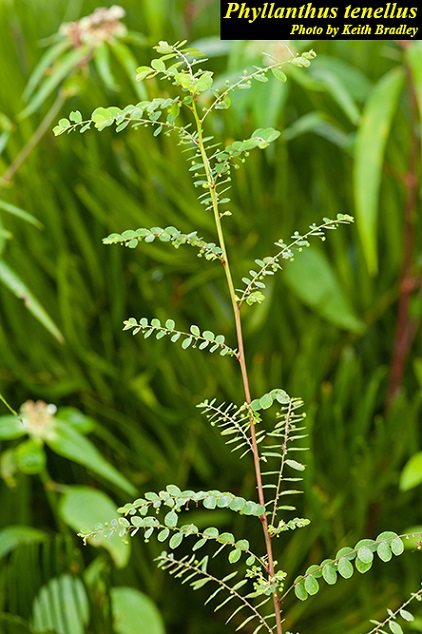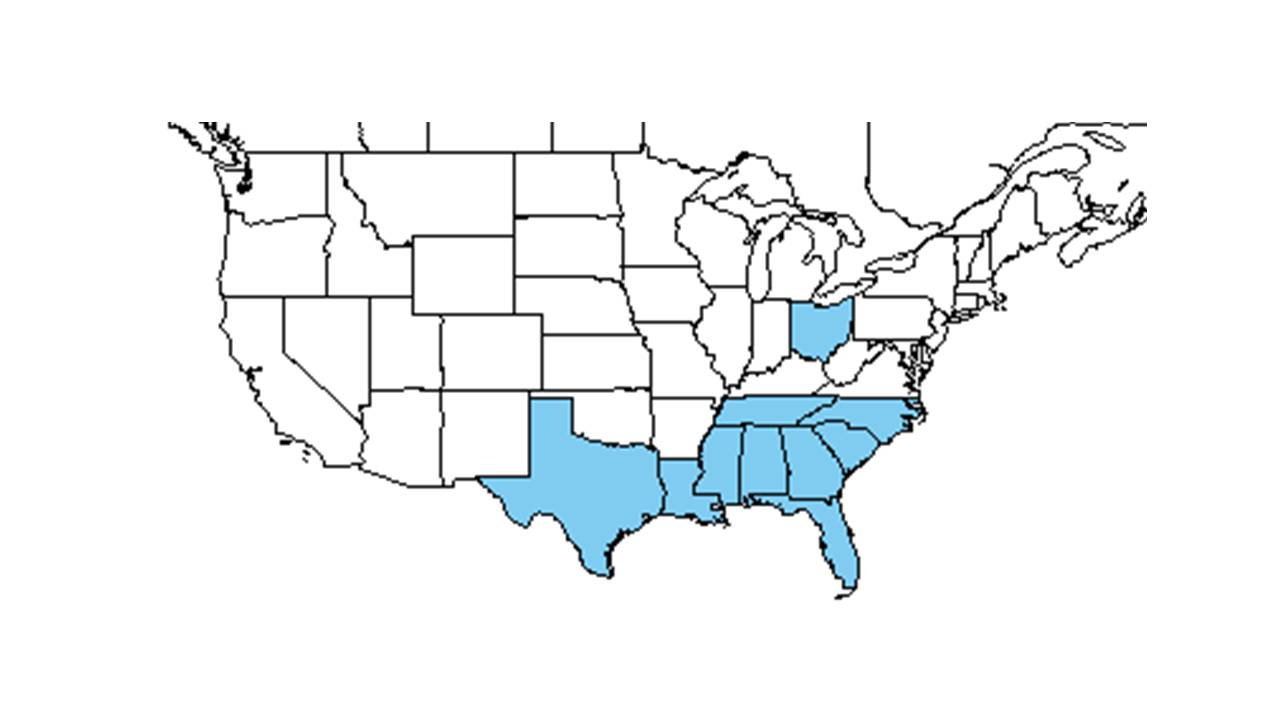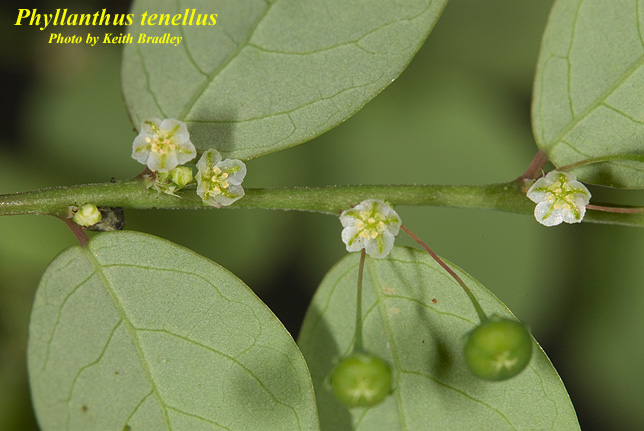Difference between revisions of "Phyllanthus tenellus"
Laurenloria (talk | contribs) |
Emmazeitler (talk | contribs) |
||
| Line 18: | Line 18: | ||
}} | }} | ||
| − | Common name: Mascarene Island leaf-flower | + | Common name: Mascarene Island leaf-flower<ref name="weakley">Weakley, A.S. 2015. Flora of the southern and mid-atlantic states. Working Draft of 21 May 2015. University of North Carolina at Chapel Hill, Chapel Hill, North Carolina.</ref> |
==Taxonomic notes== | ==Taxonomic notes== | ||
| − | + | Synonyms: ''P. amarus''.<ref name="weakley">Weakley, A.S. 2015. Flora of the southern and mid-atlantic states. Working Draft of 21 May 2015. University of North Carolina at Chapel Hill, Chapel Hill, North Carolina.</ref> | |
| + | |||
| + | Varieties: none.<ref name="weakley">Weakley, A.S. 2015. Flora of the southern and mid-atlantic states. Working Draft of 21 May 2015. University of North Carolina at Chapel Hill, Chapel Hill, North Carolina.</ref> | ||
==Description== | ==Description== | ||
<!-- Basic life history facts such as annual/perrenial, monoecious/dioecious, root morphology, seed type, etc. --> | <!-- Basic life history facts such as annual/perrenial, monoecious/dioecious, root morphology, seed type, etc. --> | ||
| + | This plant has a “phyllanthoid” arrangement of branches, leaves, and flowers. It has 5 stamens, free filaments, fruiting pedicels, that are 3-7 mm long. The seeds are densely papillose.<ref name="weakley">Weakley, A.S. 2015. Flora of the southern and mid-atlantic states. Working Draft of 21 May 2015. University of North Carolina at Chapel Hill, Chapel Hill, North Carolina.</ref> | ||
==Distribution== | ==Distribution== | ||
| + | ''P. tenellus'' is a native of the Mascarene Islands and began spreading throughout the U.S. in the mid-20th century. It extends from Florida to southern Georgia, South Carolina, North Carolina, and Tennessee.<ref name="weakley">Weakley, A.S. 2015. Flora of the southern and mid-atlantic states. Working Draft of 21 May 2015. University of North Carolina at Chapel Hill, Chapel Hill, North Carolina.</ref> | ||
| + | |||
==Ecology== | ==Ecology== | ||
===Habitat=== <!--Natural communities, human disturbed habitats, topography, hydrology, soils, light, fire regime requirements for removal of competition, etc.--> | ===Habitat=== <!--Natural communities, human disturbed habitats, topography, hydrology, soils, light, fire regime requirements for removal of competition, etc.--> | ||
| − | It can be found growing along buildings, under trees in dry loamy sand of cultivated fields, and in moist loam in cultivated flower gardens and lawns. <ref name="FSU Herbarium">Florida State University Robert K. Godfrey Herbarium database. URL: [http://herbarium.bio.fsu.edu http://herbarium.bio.fsu.edu]. Last accessed: July 2015. Collectors: Robert K. Godfrey, R. L. Wilbur, E. L. Dunn, H. A. Hespenheide, D. R. Wiseman, Loran C. Anderson, T. MacClendon, K. MacClendon, Geo. Wilder. States and Counties: Florida: Calhoun, Jefferson, Leon. Dominica. Compiled by Tall Timbers Research Station and Land Conservancy.</ref> | + | It can be found growing along buildings, under trees in dry loamy sand of cultivated fields, and in moist loam in cultivated flower gardens and lawns.<ref name="FSU Herbarium">Florida State University Robert K. Godfrey Herbarium database. URL: [http://herbarium.bio.fsu.edu http://herbarium.bio.fsu.edu]. Last accessed: July 2015. Collectors: Robert K. Godfrey, R. L. Wilbur, E. L. Dunn, H. A. Hespenheide, D. R. Wiseman, Loran C. Anderson, T. MacClendon, K. MacClendon, Geo. Wilder. States and Counties: Florida: Calhoun, Jefferson, Leon. Dominica. Compiled by Tall Timbers Research Station and Land Conservancy.</ref> |
===Phenology=== <!--Timing off flowering, fruiting, seed dispersal, and environmental triggers. Cite PanFlora website if appropriate: http://www.gilnelson.com/PanFlora/ --> | ===Phenology=== <!--Timing off flowering, fruiting, seed dispersal, and environmental triggers. Cite PanFlora website if appropriate: http://www.gilnelson.com/PanFlora/ --> | ||
It has been observed flowering in January.<ref>Nelson, G. [http://www.gilnelson.com/ PanFlora]: Plant data for the eastern United States with emphasis on the Southeastern Coastal Plains, Florida, and the Florida Panhandle. www.gilnelson.com/PanFlora/ Accessed: 12 DEC 2016</ref> | It has been observed flowering in January.<ref>Nelson, G. [http://www.gilnelson.com/ PanFlora]: Plant data for the eastern United States with emphasis on the Southeastern Coastal Plains, Florida, and the Florida Panhandle. www.gilnelson.com/PanFlora/ Accessed: 12 DEC 2016</ref> | ||
<!--===Seed dispersal===--> | <!--===Seed dispersal===--> | ||
===Seed bank and germination=== | ===Seed bank and germination=== | ||
| − | Seed density observed to be highest three years post-fire. <ref> Navarra, J. J., N. Kohfeldt, et al. (2011). "Seed bank changes with time since fire in Florida rosemary scrub." Fire Ecology 7(2). </ref> | + | Seed density observed to be highest three years post-fire.<ref> Navarra, J. J., N. Kohfeldt, et al. (2011). "Seed bank changes with time since fire in Florida rosemary scrub." Fire Ecology 7(2). </ref> |
<!--===Fire ecology===--> <!--Fire tolerance, fire dependence, adaptive fire responses--> | <!--===Fire ecology===--> <!--Fire tolerance, fire dependence, adaptive fire responses--> | ||
<!--===Pollination===--> | <!--===Pollination===--> | ||
Revision as of 15:59, 16 November 2020
| Phyllanthus tenellus | |
|---|---|

| |
| Photo by Keith Bradley, Atlas of Florida Vascular Plants | |
| Scientific classification | |
| Kingdom: | Plantae |
| Division: | Magnoliophyta - Flowering plants |
| Class: | Magnoliopsida – Dicotyledons |
| Order: | Euphorbiales |
| Family: | Euphorbiaceae |
| Genus: | Phyllanthus |
| Species: | P. tenellus |
| Binomial name | |
| Phyllanthus tenellus Roxb. | |

| |
| Natural range of Phyllanthus tenellus from USDA NRCS Plants Database. | |
Common name: Mascarene Island leaf-flower[1]
Contents
Taxonomic notes
Synonyms: P. amarus.[1]
Varieties: none.[1]
Description
This plant has a “phyllanthoid” arrangement of branches, leaves, and flowers. It has 5 stamens, free filaments, fruiting pedicels, that are 3-7 mm long. The seeds are densely papillose.[1]
Distribution
P. tenellus is a native of the Mascarene Islands and began spreading throughout the U.S. in the mid-20th century. It extends from Florida to southern Georgia, South Carolina, North Carolina, and Tennessee.[1]
Ecology
Habitat
It can be found growing along buildings, under trees in dry loamy sand of cultivated fields, and in moist loam in cultivated flower gardens and lawns.[2]
Phenology
It has been observed flowering in January.[3]
Seed bank and germination
Seed density observed to be highest three years post-fire.[4]
Conservation and management
Cultivation and restoration
Photo Gallery
Phyllanthus tenellus flowers Photo by Keith Bradley, Atlas of Florida Vascular Plants
References and notes
- ↑ 1.0 1.1 1.2 1.3 1.4 Weakley, A.S. 2015. Flora of the southern and mid-atlantic states. Working Draft of 21 May 2015. University of North Carolina at Chapel Hill, Chapel Hill, North Carolina.
- ↑ Florida State University Robert K. Godfrey Herbarium database. URL: http://herbarium.bio.fsu.edu. Last accessed: July 2015. Collectors: Robert K. Godfrey, R. L. Wilbur, E. L. Dunn, H. A. Hespenheide, D. R. Wiseman, Loran C. Anderson, T. MacClendon, K. MacClendon, Geo. Wilder. States and Counties: Florida: Calhoun, Jefferson, Leon. Dominica. Compiled by Tall Timbers Research Station and Land Conservancy.
- ↑ Nelson, G. PanFlora: Plant data for the eastern United States with emphasis on the Southeastern Coastal Plains, Florida, and the Florida Panhandle. www.gilnelson.com/PanFlora/ Accessed: 12 DEC 2016
- ↑ Navarra, J. J., N. Kohfeldt, et al. (2011). "Seed bank changes with time since fire in Florida rosemary scrub." Fire Ecology 7(2).
